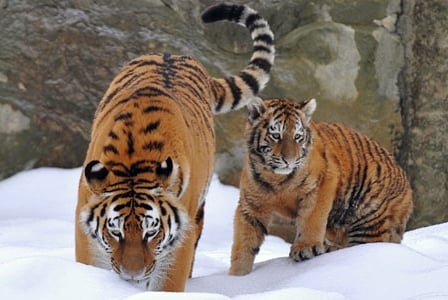
Theyre striped, fuzzy, and really adorable. Learn about Amur tigers with us on this Wildlife Wednesday.
These ferocious felines—the largest cat species in the world—were hunted to the brink of extinction. However, with the help of governments and conservation organizations, they’ve been bounding back from that precipice.
Let’s all give the Amur tiger a big round of applause, and then learn a little more about them on this Wildlife Wednesday.
Habitat
Primarily, these tigers are found in the many river valleys and mixed forests in eastern Russia, northeast China, and (possibly) North Korea.
Trivia
- Amur tigers can weigh about 660 lb (300 kg) and stretch 4 m (13 ft) from whiskers to tail. As a result, their appetites are sized to match—a hungry tigers can eat as much as 60 lb (27 kg) in one night!
- To fuel that ravenous appetite, these stalk-and-ambush hunters prey on appropriately large animals, such as deer, boars, and the occasional fish.
- Like other tigers, these oversized cats have broad stripes that coat their coats. These stripes are sort of like a tiger’s fingerprint, as no two tigers have the same pattern on their fur.
- Unlike other tigers, the Amur tiger must survive freezing cold climates and long, snowy winters. Their coats are longer and thicker than those of other subspecies, and they have a layer of fat for insulation.
- These huge hunters were once most commonly known as Siberian tigers, as they were first found in the Russian province of—you guessed it—Siberia. However, their territory has been so restricted that their name changed to reflect that the Amur River now runs through much of their current range.
Why are they threatened?
By the 1940s, the wild Amur tiger population was estimated to be no more than 40 cats remaining. When Russia outlawed the hunting of tigers in 1947, that tiny population began to blossom, rising to about 500 by the 1980s before stabilizing to today’s current estimates of 450 cats in the wild.
However, the threats that these outrageously orange felines face are very real and very human-caused, with some estimates claiming that human intervention causes as many as 80 percent of the tiger deaths in Russia.
Some of those threats include loss of habitat and less prey due to logging and agricultural practices, urban expansion, mining, and road construction; loss of prey due to overhunting; and human-tiger conflicts when the cats turn to livestock as a source of prey.
The biggest threat, though, is poaching and the black market demand for tiger skin, fur, bones, and organs.

